
The term Pool of Siloam refers to a number of rock-cut pools on the southern slope of the Wadi Hilweh, considered by some archaeologists to be the original site of Jerusalem, located outside the walls of the Old City to the southeast. The pools were fed by the waters of the Gihon Spring, carried there by the Siloam Tunnel.

The City of David, known locally mostly as Wadi Hilweh, is the name given to an archaeological site considered by most scholars to be the original settlement core of Jerusalem during the Bronze and Iron Ages. It is situated on southern part of the eastern ridge of ancient Jerusalem, west of the Kidron Valley and east of the Tyropoeon valley, to the immediate south of the Temple Mount.

The archaeology of Israel is the study of the archaeology of the present-day Israel, stretching from prehistory through three millennia of documented history. The ancient Land of Israel was a geographical bridge between the political and cultural centers of Mesopotamia and Egypt. Despite the importance of the country to three major religions, serious archaeological research only began in the 15th century. Although he never travelled to the Levant, or even left the Netherlands, the first major work on the antiquities of Israel is considered to be Adriaan Reland's Antiquitates Sacrae veterum Hebraeorum, published in 1708. Edward Robinson, an American theologian who visited the country in 1838, published its first topographical studies. Lady Hester Stanhope performed the first modern excavation at Ashkelon in 1815. A Frenchman, Louis Felicien de Saucy, embarked on early "modern" excavations in 1850. Today, in Israel, there are some 30,000 sites of antiquity, the vast majority of which have never been excavated.

Israel Finkelstein is an Israeli archaeologist, professor emeritus at Tel Aviv University and the head of the School of Archaeology and Maritime Cultures at the University of Haifa. Finkelstein is active in the archaeology of the Levant and is an applicant of archaeological data in reconstructing biblical history. He is also known for applying the exact and life sciences in archaeological and historical reconstruction. Finkelstein is the current excavator of Megiddo, a key site for the study of the Bronze and Iron Ages in the Levant.

Mount Zion is a hill in Jerusalem, located just outside the walls of the Old City. The term Mount Zion has been used in the Hebrew Bible first for the City of David and later for the Temple Mount, but its meaning has shifted and it is now used as the name of ancient Jerusalem's Western Hill. In a wider sense, the term Zion is also used for the entire Land of Israel.
Pithom was an ancient city of Egypt. References in the Hebrew Bible and ancient Greek and Roman, sources exist for this city, but its exact location remains somewhat uncertain. A number of scholars identified it as the later archaeological site of Tell el-Maskhuta. Others identified it as the earlier archaeological site of Tell El Retabeh.
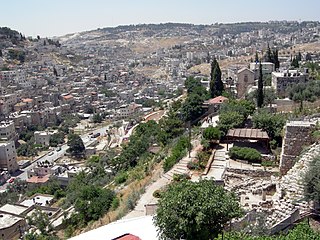
Kidron Valley is the modern name of the valley originating slightly northeast of the Old City of Jerusalem, which then separates the Temple Mount from the Mount of Olives, and ending at the Dead Sea. Beyond Jerusalem it continues in a general south-easterly direction through the Judean desert in the West Bank, reaching the Dead Sea near the settlement of Ovnat, and descending 4,000 feet (1,200 m) along its 20-mile (32 km) course.

Es-Skhul or the Skhul Cave is a prehistoric cave site situated about 20 kilometres south of the city of Haifa, Israel, and about 3 km (1.9 mi) from the Mediterranean Sea.

The Besor is a wadi in southern Israel. The stream begins at Mount Boker, and spills into the Mediterranean Sea near Al-Zahra in the Gaza Strip, where it is called Wadi Gaza, also spelled Wadi Ghazza or Wadi 'Azza. Further upstream it is marked as Wadi esh-Shallaleh on the 1878 Survey of Western Palestine map. There are several important archaeological sites located in this area.

William M. Schniedewind holds the Kershaw Chair of Ancient Eastern Mediterranean Studies and is a Professor of Biblical Studies and Northwest Semitic Languages at the University of California, Los Angeles.
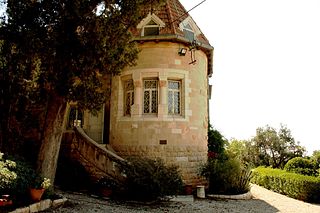
The German Protestant Institute of Archaeology (GPIA), Research Unit of the German Archaeological Institute, founded in 1900 is one of the most important biblical archaeological institutes in the Near East. Its German name is Deutsches Evangelisches Institut für Altertumswissenschaft des Heiligen Landes (DEI).

Silwan or Siloam is a predominantly Palestinian district in East Jerusalem, on the southeastern outskirts of the current Old City of Jerusalem.
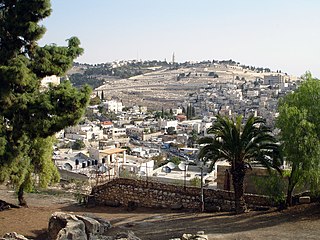
Ophel, also Graecised to ophlas, is the biblical term given to a certain part of a settlement or city that is elevated from its surroundings, and probably means fortified hill or risen area. In the Hebrew Bible, the term is used in reference to two cities: Jerusalem, as in the Book of Chronicles and Book of Nehemiah, and Samaria, mentioned in the Books of Kings. The Mesha Stele, written in Moabite, a Canaanite language closely related to Biblical Hebrew, is the only extra-biblical source using the word, also in connection to a fortified place.
Wadi al-Far'a is a Palestinian village in the Tubas Governorate in the northeastern West Bank located five kilometers southwest of Tubas. It has a land area of 12,000 dunams, of which 337 is built-up and 10,500 are for agricultural purposes. It is under the complete control of the Palestinian National Authority and is adjacent to the Far'a refugee camp. According to the Palestinian Central Bureau of Statistics, Wadi al-Far'a had a population of 2,340 inhabitants.

Adam Zertal was an Israeli archaeologist and a tenured professor at the University of Haifa.
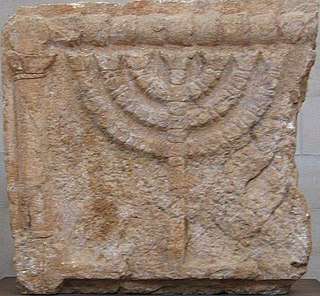
Ancient synagogues in Palestine refers to synagogues and their remains in the Palestine region, built by the Jewish and Samaritan communities from the time of the Hasmonean dynasty during the Late Hellenistic period, to the Late Byzantine period.

The Ophel ostracon or KAI 190, is an ostracon discovered in Jerusalem in 1924 by R. A. Stewart Macalister and John Garrow Duncan, in the area of Wadi Hilweh. It is attributed to the 7th century BCE.
Raymond Weill was a French archaeologist specialized in Egyptology.
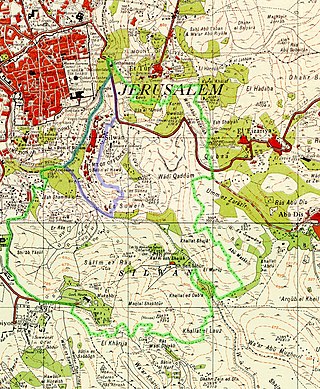
Wadi Hilweh is a neighborhood in the Palestinian Arab village of Silwan, intertwined with an Israeli settlement. The Silwan area of East Jerusalem was annexed by Israel following the 1967 Six-Day War and 1980 Jerusalem Law, an action not recognized internationally. The international community regards Israeli settlements as illegal under international law, although Israel disputes this.















